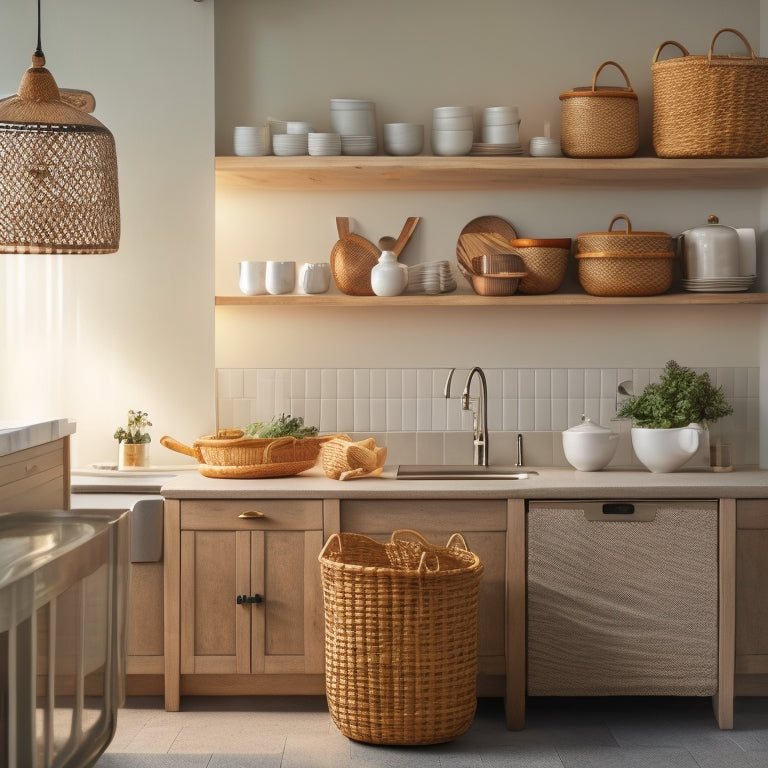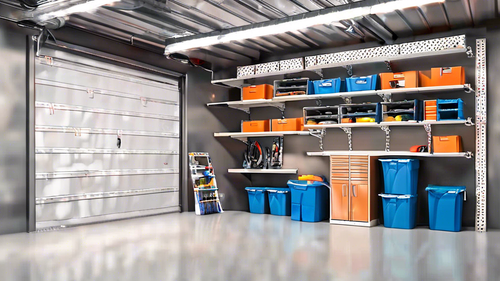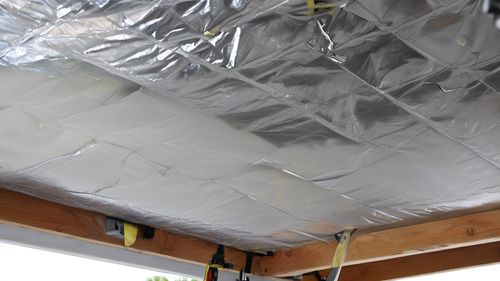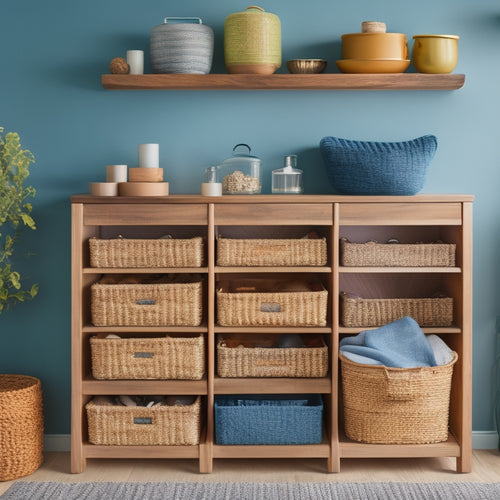
Why Kitchen Storage Matters for a Clutter-Free Space
Share
You're tired of feeling frustrated in your cluttered kitchen, where wasted time and energy are the norm. The culprit? Poor kitchen storage. It's not just about having enough space, but about creating a system that lets you work efficiently and stay organized. By maximizing vertical storage, utilizing corner areas, and placing essentials in easy reach, you'll clear clutter and streamline your workflow. By implementing these strategies, you'll be able to focus on cooking, not searching for lost ingredients. Now, discover the specific solutions that'll transform your kitchen into a clutter-free haven, perfectly tailored to your needs.
Key Takeaways
• Maximizing vertical storage space and utilizing corner areas effectively helps reduce clutter and increase efficiency in the kitchen.
• Optimal placement of essentials within easy reach streamlines workflow and reduces clutter, while storing less used items in harder-to-reach areas.
• Clearing countertop clutter and decluttering kitchen cabinets creates a clean slate, allowing for the implementation of organization strategies and task segregation areas.
• Utilizing kitchen storage solutions, such as drawer dividers and custom inserts, creates zones for specific tasks, enhancing organization and efficiency.
• Maintaining a clutter-free workflow by clearing clutter and cleaning up as you go prevents mess buildup and promotes a smooth cooking process.
Maximizing Vertical Storage Space
By installing shelves, hooks, or a pegboard that stretch all the way to the ceiling, you can effectively double or even triple your kitchen's vertical storage space. This is one of the most effective storage hacks to maximize your kitchen's potential.
By utilizing the space between the ceiling and your countertops, you can store infrequently used items, freeing up valuable real estate for daily essentials.
To take it to the next level, consider implementing additional organization tips such as categorizing items by frequency of use or grouping similar items together. This will enable you to quickly locate what you need, saving you time and reducing stress.
Incorporating space-saving solutions like baskets, bins, or containers can also help keep your kitchen organized and clutter-free. By adopting these vertical storage ideas, you'll be amazed at how much more functional and efficient your kitchen becomes.
Utilizing Corner Areas Effectively
Now that you've maximized your kitchen's vertical storage space, it's time to tackle those notoriously tricky corner areas, where pots, pans, and utensils often get stuck in a cluttered, hard-to-reach limbo. These areas can be an important pain point, making it difficult to find what you need when you need it.
But fear not, with the right strategies, you can transform these corners into functional and accessible spaces.
Lazy Susan solutions are a great way to make the most of corner areas. By installing a Lazy Susan in a corner cabinet, you can easily access items that would otherwise be out of reach.
Another option is to incorporate hidden storage solutions, such as pull-out drawers or shelves, to keep items concealed yet accessible.
Corner cabinet organization is also essential. Consider installing a carousel storage system, which allows you to rotate and access items with ease.
By optimizing your corner areas, you'll be able to find what you need quickly, reducing clutter and increasing your kitchen's overall functionality.
With a little creativity and planning, you can turn these once-problematic areas into efficient and convenient spaces that make cooking and entertaining a breeze.
Optimal Placement for Essentials
You'll save time and reduce frustration in the kitchen by strategically placing your most frequently used items in easy-to-reach locations. This functional organization guarantees that essential items are always within arm's reach, allowing you to focus on cooking rather than searching for utensils or ingredients.
By optimizing storage, you'll create a seamless workflow that boosts your productivity and efficiency. To achieve this, identify your most-utilized items, such as pots, pans, utensils, and spices, and assign them prime real estate in your kitchen.
Install shelves, hooks, or a pegboard near your cooking station to keep frequently used items within easy reach. Store less frequently used items, like special occasion dishes or infrequently used cookbooks, in harder-to-reach areas, such as upper shelves or cabinets.
Streamlining Countertop Clutter
When you're ready to tackle countertop clutter, start by clearing everything off the counter space - yes, everything! This will give you a clean slate to work with, and you'll be able to see what you really need to keep out.
From there, you can begin the process of decluttering your kitchen essentials and assigning a home for each item.
Clear the Counter Space
By paring down countertop mess, you can create a more efficient and enjoyable cooking experience. Clearing mess and organizing chaos is essential to achieve a clutter-free kitchen. Start by evaluating what's essential and what can be stored away. Be ruthless – if you haven't used it in the past month, it's probably safe to store it or let it go.
Next, consider functional storage solutions that also offer aesthetic appeal. A stylish utensil holder or a sleek spice rack can keep your countertops tidy while adding a touch of sophistication to your kitchen.
Install a pegboard or a pot rack to maximize vertical storage and free up counter space. Remember, the goal is to create a streamlined workspace that allows you to focus on cooking, not assessing clutter.
Declutter Kitchen Essentials
Now that your countertops are clear, it's time to tackle the items you use regularly, like appliances, gadgets, and utensils, and figure out which ones are worth keeping out and which can be stored away. This is where the real decluttering begins. Take a closer look at each item and ask yourself, "Do I use this daily?" or "Can I easily access it when I need it?"
| Keep Out | Store Away |
|---|---|
| Frequently used appliances (e.g., coffee maker, toaster) | Infrequently used gadgets (e.g., bread maker, ice cream maker) |
| Utensils you use daily (e.g., chef's knife, cutting board) | Special occasion utensils (e.g., cake server, pastry brush) |
| Spices and oils you use regularly | Rarely used spices or specialty oils |
| Frequently accessed cookbooks or recipe cards | Infrequently used cookbooks or recipe cards |
| Countertop canisters for daily snacks | Special occasion serving dishes |
As you sort through your kitchen essentials, remember that organizing utensil drawers and clearing pantry shelves will also help you maintain a clutter-free space. By storing away items you don't use frequently, you'll create a more streamlined kitchen that's easier to navigate and enjoy.
Assign a Home
Assign a Home (Streamlining Countertop Clutter)
You'll want to designate a specific spot for each item you've decided to keep out, ensuring that everything has a logical and convenient home on your countertops. This means allocating designated storage for frequently used items like oils, spices, and utensils. By doing so, you'll create a sense of order and make meal prep more efficient.
Implementing organization systems, such as a spice rack or utensil holder, can help maintain your newly assigned homes. These systems keep items off the countertops, freeing up space and reducing visual clutter. Consider a Lazy Susan for corner storage or a knife block to keep countertops clear.
Assigning a home for each item encourages accountability and makes it easier to maintain your clutter-free space. By establishing a system, you'll be more likely to put things back in their designated spot, keeping your kitchen organized and functional.
Decluttering Kitchen Cabinets
You've likely opened your kitchen cabinet doors to find a jumbled mess of cookware, dinnerware, and gadgets, making it difficult to locate what you need when you need it. This cluttered space can be overwhelming, but decluttering your kitchen cabinets is an essential step in achieving a clutter-free kitchen.
To start, take everything out of your cabinets and sort items into categories. This will give you a clear view of what you have and what you can get rid of. Consider the items you use frequently and those that are duplicates or no longer needed.
| Category | Keep | Donate/Sell | Toss |
|---|---|---|---|
| Pots and Pans | Frequently used | Duplicates or unused | Rusty or damaged |
| Tupperware | Lids that match | Lids without containers | Broken or stained |
| Kitchen Gadgets | Frequently used | Unused or broken | Expired or obsolete |
| Dinnerware | Complete sets | Incomplete or broken sets | Chipped or cracked |
Efficient Use of Drawer Space
After decluttering your kitchen cabinets, turn your attention to maximizing the storage potential of your drawers, where the right organizational systems can make a huge difference in your kitchen's overall functionality.
You'll be amazed at how much more efficient you can be when everything has its designated spot. To get started, consider using drawer dividers to separate items into categories. This will prevent clutter from building up again and make it easier to find what you need.
For a more customized approach, look into custom drawer inserts that can be tailored to your specific needs. These can be designed to hold specific items, such as utensils, spices, or cooking tools, and can be adjusted as your needs change.
Creating Zones for Tasks
As you design your kitchen's storage, you'll want to create zones that cater to specific tasks, making it easier to stay organized and focused.
By setting up task segregation areas, you'll be able to contain clutter and keep similar items together.
You'll also want to designate dedicated workspace zones, allowing you to complete tasks efficiently and without distractions.
Task Segregation Areas
Creating task segregation areas in your kitchen enables you to dedicate specific zones to specific tasks, thereby streamlining your workflow and boosting efficiency. By doing so, you can optimize your space and organize tasks in a way that makes sense for your cooking style.
For instance, you can create a prep zone near the sink, a cooking zone near the stove, and a cleaning zone near the dishwasher. This segregation of tasks allows you to focus on one task at a time, reducing clutter and chaos in the process.
As you create these task segregation areas, consider the tools and utensils you need for each task. Store them in designated areas to maintain easy access and reduce clutter. For example, keep your mixing bowls and utensils near the prep zone, and your pots and pans near the cooking zone.
Dedicated Workspace Zones
Designate specific zones within your kitchen for tasks like food preparation, cooking, and cleanup to maximize workflow efficiency and reduce clutter. By doing so, you'll create a more organized and functional space that allows you to work smarter, not harder. Zone organization is key to achieving workspace efficiency, as it enables you to allocate tasks to specific areas, reducing the risk of clutter and chaos.
For instance, designate a zone near the sink for cleanup, where you can store dish soap, sponges, and a trash can. This will keep the area tidy and make cleanup a breeze.
Similarly, allocate a zone near the stove for cooking, where you can store pots, pans, and utensils. This will streamline your cooking process and reduce clutter.
Maintaining a Clutter-Free Workflow
You'll find that clearing clutter from your countertops and floors is essential to maintaining a smooth workflow in the kitchen. A cluttered kitchen can lead to chaos, making it difficult to focus on cooking and preparing meals. By optimizing your kitchen's space and implementing workflow organization strategies, you'll be able to move efficiently from one task to the next.
Here are three ways to maintain a clutter-free workflow:
-
Designate a 'landing strip':
Designate a specific area, such as a utensil organizer or a tray near the sink, as a 'landing strip' for frequently used items. This will keep them organized and within reach. -
Implement a 'clean as you go' policy:
Clean up as you go to prevent crumbs, spills, and other messes from building up. This will save you time in the long run and keep your kitchen functional. -
Store items by frequency of use:
Store items you use daily in easy-to-access locations, and reserve harder-to-reach areas for less frequently used items. This will streamline your workflow and reduce clutter.
Frequently Asked Questions
How Do I Store Heavy Cookware Without Damaging Cabinets or Shelves?
Imagine a kitchen avalanche, with pots and pans crashing down, damaging cabinets and shelves. You prevent this by storing heavy cookware on sturdy, adjustable shelves or in reinforced cabinets with weight-distributed storage solutions, safeguarding both your cookware and cabinet integrity.
Can I Use Adhesive Hooks on My Kitchen Walls Without Damaging Paint?
You can use adhesive hooks on your kitchen walls without damaging the paint if you opt for removable options like 3M Command Hooks or versatile alternatives like over-the-door hooks, which offer temporary solutions that are damage-free.
Are There Any Kitchen Storage Solutions for Renters With Limited Installation Options?
You might think you're limited by your rental situation, but don't worry, you can still achieve a clutter-free kitchen. Opt for portable organizers, hanging baskets, over-the-door racks, and magnetic hooks that require minimal installation or no drilling at all!
How Often Should I Clean and Reorganize My Kitchen Storage Spaces?
You should clean and reorganize your kitchen storage spaces every 1-3 months, depending on usage, to maintain a clutter-free space; establish a routine to wipe down shelves, sort items, and purge expired goods for best storage frequency and organization.
Can Kitchen Storage Systems Be Customized for Unique Kitchen Layouts?
"Measure twice, cut once" - wise words for kitchen storage customization. You can tailor solutions to your unique layout with customized shelving, versatile organizers, and space-saving solutions that create efficient layouts, maximizing your kitchen's potential.
Related Posts
-

Organize Your Garage Overhead Storage: A Quick Guide
As a homeowner, you know that keeping your garage organized can be a challenge. If your garage is anything like m...
-

Vapor Barriers in Garage Ceilings: When and Why You Need Them
As a seasoned home improvement expert, I've witnessed firsthand the transformative power of a well-maintained gar...
-

Declutter Your Drawers: 10 Genius Storage Hacks
You can breathe new life into your cluttered drawers by implementing a few genius storage hacks. Start by maximizing ...


